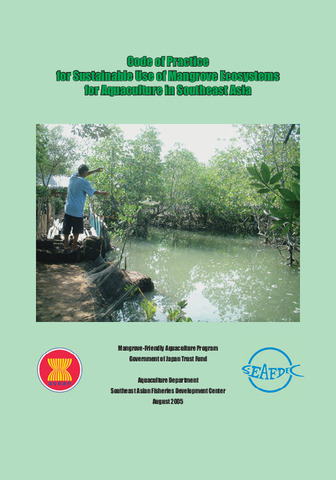An innovative biofloc technology for the nursery production of Pacific whiteleg shrimp, Penaeus vannamei in tanks
| dc.contributor.author | Caipang, Christopher Marlowe | |
| dc.contributor.author | Trebol, Kathleen Mae P. | |
| dc.contributor.author | Abeto, Marian Jill S. | |
| dc.contributor.author | Coloso, Relicardo M. | |
| dc.contributor.author | Pakingking, Rolando V., Jr. | |
| dc.contributor.author | Calpe, Adelaida T. | |
| dc.contributor.author | Deocampo, Joel E., Jr. | |
| dc.date.accessioned | 2022-11-08T09:02:38Z | |
| dc.date.available | 2022-11-08T09:02:38Z | |
| dc.date.issued | 2022-10-09 | |
| dc.identifier.citation | Caipang, C. M. A., Trebol, K. M. P., Abeto, M. J. S., Coloso, R. M., Pakingking, Jr., R. V., Calpe, A. T., & Deocampo Jr., J. E. (2022). An innovative biofloc technology for the nursery production of Pacific whiteleg shrimp, Penaeus vannamei in tanks. International Journal of Biosciences, 21(4), 71–79. https://doi.org/10.12692/ijb/21.4.71-79 | en |
| dc.identifier.issn | 2220-6655 | |
| dc.identifier.uri | http://hdl.handle.net/10862/6395 | |
| dc.description.abstract | Nursery production of shrimp is usually done in small ponds; however, the use of small and circular tanks with plastic liners is gaining popularity. From an industry standpoint, there is still a need to assess how nursery systems can be of benefit to the shrimp production cycle. Hence, the use of small circular tanks coupled with the incorporation of biofloc technology was assessed in terms of its viability during the nursery production of the Pacific whiteleg shrimp, Penaeus vannamei. A 450m2 plastic lined circular tank was installed and prepared for the stocking of P. vannamei postlarvae (PLs) at a density of 500 PLs per m2. Biofloc was produced and maintained throughout the nursery phase using brown sugar as carbon source at a carbon to nitrogen (C:N) ratio of 10. Water quality was monitored daily, while presumptive Vibrios were enumerated weekly. Sampling for growth was done at the 14th day post-stocking and weekly until harvest on the 30th day. The different water quality parameters were within optimum levels required for shrimp growth. Presumptive Vibrios were dominated by the yellow colonies. At the end of the nursery phase, there was 100% survival and the shrimp attained an average body weight of 1.26 g and a feed conversion ratio (FCR) of 0.43. Our results indicate that the use of small circular tanks with biofloc during the nursery production phase of whiteleg shrimp is feasible and can be incorporated in the grow-out culture of this shrimp species. | en |
| dc.description.sponsorship | This research study is part of the project, “Bioflocbased Nursery Tank Production of Shrimp for Quality and Sustainable Supply of Aquaculture Products in the New Normal” funded by the Department of Science and Technology (DOST) through the Science for Change Program (S4CP) – Collaborative Research and Development to Leverage Philippine Economy (CRADLE) and monitored by DOST – Philippine Council for Agriculture, Aquatic and Natural Resources Research and Development (PCAARRD) with Project Number 8444 awarded to CMA Caipang. The support provided by our respective institutional affiliations and Marmi Agricultural Corporation is gratefully acknowledged. | en |
| dc.language.iso | en | en |
| dc.publisher | International Network for Natural Sciences | en |
| dc.relation.uri | https://www.innspub.net/wp-content/uploads/2022/10/IJB-V21-No4-p71-79.pdf | en |
| dc.subject | Penaeus vannamei | en |
| dc.title | An innovative biofloc technology for the nursery production of Pacific whiteleg shrimp, Penaeus vannamei in tanks | en |
| dc.type | Article | en |
| dc.identifier.doi | 10.12692/ijb/21.4.71-79 | |
| dc.citation.volume | 21 | |
| dc.citation.issue | 4 | |
| dc.citation.spage | 71 | |
| dc.citation.epage | 79 | |
| dc.citation.journalTitle | International Journal of Biosciences | en |
| dc.subject.asfa | biofloc technology | en |
| dc.subject.asfa | hydroponics | en |
| dc.subject.asfa | nursery ponds | en |
| dc.subject.asfa | tanks | en |
| dc.subject.asfa | shrimp culture | en |
| dc.identifier.essn | 2222-5234 | |
| dc.subject.scientificName | Penaeus vannamei | en |
| local.subject | Aquaculture | en |
| local.subject | Aquatic | en |
| local.subject | BFT | en |
| local.subject | Heterotrophic bacteria | en |
| local.subject | Water quality | en |
Files in this item
| Files | ขนาด | รูป | View |
|---|---|---|---|
|
There are no files associated with this item. |
|||
รายการนี้ปรากฏใน (s)
-
Journal Articles [1256]
These papers were contributed by Department staff to various national and international journals.




